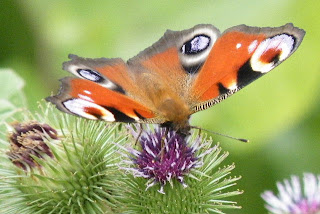I still haven't figured out how to organise the photos how I want them on the blog, so my walk is represented backwards pictorially!
It has been a fantastic year for fruit, sloes in particular, and the hedgerows are rich too with hips and haws, blackberries, guelder fruits and elderberries - an abundance of red and purple that is so good for us, particularly our blood vessels and immune systems. I've been busy making elderberry and hawthorn and rosehip syrups, and sloe gin and damson vodka - purely for medicinal purposes of course!
It was a beautiful day to start, and I walked along the banks of the Cam, through the meadow and into the Magic Kingdom (the site of the old railway track). It's magic to me because it grows different things to the rest of the land around, and is particularly beautiful - when the cows are pastured elsewhere and haven't churned it into a quagmire!
The butterbur by the Cam is dying back and looking beautiful as the leaves dry and curl inwards to form giant vessels. The Himalayan Balsam is still blooming and filling the air with the sweet smell and the hum of bees, and the brook itself was limpid and reflecting the fading leaves - a beautiful tapestry of pale greens.
Although I love the Balsam it is becoming invasive around here - spreading itself into the Meadow and along into Little Scotland (the wooded part of the Cam by one of the old slag heaps called 'batches'). It seems to be overtaking the wild angelica here, which is a shame.
As I walked along the meadow I noticed a fluttering in the grass. Looking down at my feet I counted five Small Copper butterflies sunning themselves on the ground. Some were very tattered and some were much smarter - is it an age thing or do some of them just lead a more rough and tumble life?!
The Magic Kingdom revealed more treasures - a wild pear tree that had tiny but perfectly formed windfalls - some of which I gathered and took home to stew - lovely. I also found a mullein blooming, which was handy as I have a friend who goes diving and has trouble with her ears afterwards. Mullein flowers are great for all sorts of ear troubles, made into an infused oil - I picked a few and took them home to do just that.
I also found some Field Speedwell (it has one white petal) and some Shepherds purse looking like a supernova!
As I left to go back down into the meadow the rain clouds were gathering, and two buzzards were wheeling and crying overhead, as if telling of the coming storm. Some claps of thunder made me hurry into the woods to shelter, and to watch the torrential rain making beautiful patterns on the waters surface.
As I headed home the rain eased and stopped and the sunlight broke through, making everything sparkle and glisten.
Fabulous.




















 The magestic Burdock is flowering now, in it's second year, and the bugs and butterflies love it. My walk took me past several stands of these handsome plants, so I got to see a lot of them. Burdock is also a favourite with herbalists as an 'alterative' or tissue cleanser - and I have read that in Japan they eat the root as a vegetable - they must have very clean tissues!
The magestic Burdock is flowering now, in it's second year, and the bugs and butterflies love it. My walk took me past several stands of these handsome plants, so I got to see a lot of them. Burdock is also a favourite with herbalists as an 'alterative' or tissue cleanser - and I have read that in Japan they eat the root as a vegetable - they must have very clean tissues!




































